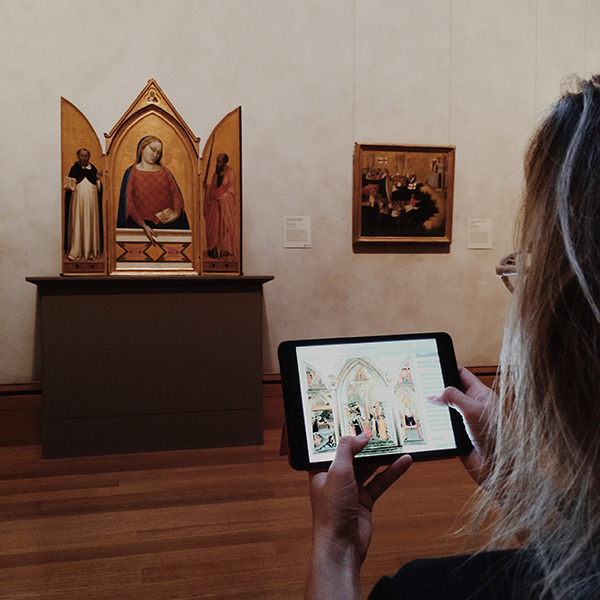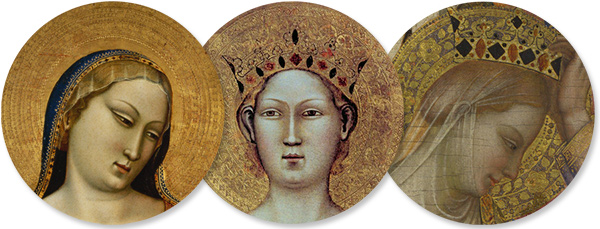
Digital tools enable visitors, and art historians, to pursue a widening web of connections. In the Getty Center galleries with Madonna, Saint Thomas Aquinas, and Saint Paul, about 1330, Bernardo Daddi. Tempera and gold leaf on panel, 47 1/2 x 22 in. The J. Paul Getty Museum, 93.PB.16
We’re really excited that James Cuno has joined the THATCamp CAA 2014 conversation, kindly responding to our invitation to author a blog post here (this essay will also be published in The Getty Iris). Cuno is president and CEO of the J. Paul Getty Trust. An art historian by training, he’s been a professor and director at several other arts institutions, including the Art Institute of Chicago; the Courtauld Institute of Art; the Harvard University Art Museums; Hood Museum of Art, Dartmouth College; the Grunwald Center for the Graphic Arts, UCLA; and Vassar College. Here he offers a kickstarter to the discussions and debates we hope will happen at THATCamp CAA 2014 in Chicago in a few short weeks.
Art museums, research centers, and libraries are central locations for the work of art history. For those of us who work in these institutions, the question of whether to embrace digital technology has long been answered, with a resounding yes. The Getty and our sister institutions around the world are digitizing collections, making content open, publishing online, using linked open data, engaging digitally with audiences, and using technology to help advance conservation and conservation studies, among many other initiatives.
As a single example, last March 7,000 volumes in the Research Library at the Getty Research Institute had been digitized. Today it’s 13,159. The challenge we face now is to recognize the new possibilities ushered in by this critical mass of digitization, and to effectively meet them as institutions and individuals.
In museums, we’ve already seen first-hand how new digital technology, protocols, and platforms can enhance visitors’ experience. At their most basic, digital tools provide an efficient conduit for information—on individual works of art and artists, exhibition themes, and public programming. But digital also gives visitors new agency in their engagement with art. High-resolution images allow the discovery of the tiniest detail. Technical images capture objects under infrared light and X-ray. 3-D objects can be digitally manipulated, and artworks from far-flung collections can be compared side by side.
It’s true that in museums we’ve often heard the concern that digital tools will distract visitors and students from genuine encounters with works of art. I believe the opposite is more often true: that digital tools enable people to direct their own learning, formulate new questions, and find unexpected connections, the raw material of intellectual discovery.
Say a visitor is at the Getty Museum looking at Bernado Daddi’s Madonna, Saint Thomas Aquinas, and Saint Paul and is intrigued by the punch work around the Virgin’s head. On her phone or tablet she searches for other Daddi paintings and finds one in the Museo dell’Opera del Duomo in Florence with very similar punch work. This leads her to search for more information on the Duomo, then 14th-century Florence, then other places in the world where Daddi paintings hang. Even if this visitor never returns to her incipient Daddi studies, she has built a mental portrait that stays with her, and may be reactivated years later when she finds herself in Edinburgh looking at Daddi’s Tryptych with the Crucifixion…and there’s that punch again. Digital enables a web of connections that are the raw material of intellectual discovery for a casual visitor, a student, or an art historian.

Punch work (designs punched into gold) was used in late-medieval
Italian painting to adorn haloes. Left: Madonna, Saint Thomas Aquinas, and Saint Paul (detail), about 1330, the J. Paul Getty Museum. Center: St Catherine of Alexandria with Donor and Christ Blessing (detail),
about 1340, Museo dell’Opera di Santa Maria del Fiore di Firenze.
Right: The Coronation of the Virgin (detail), about 1340-45, the National Gallery, London
We are at a turning point in digital art history. Now that so much primary material has been digitized by collecting institutions around the world—artworks, archives, and texts of scholarship—forward-looking art historians are teaming with technologists to forge tools with this digitized material, tools that go beyond access or documentation to create new ways of working and publishing.
This is a goal of the Getty’s Digital Mellini project, a tool to study and interpret a 17th-century manuscript collaboratively online. (Make sure to catch the lightning talk on this and its umbrella project, the Getty Scholars’ Workspace™, on Tuesday at 3:45pm by Francesca Albrezzi and Tom Scutt of the Getty Research Institute [GRI]). Under the guidance of Murtha Baca, head of digital art history at the GRI, Digital Mellini will soon culminate in a born-digital scholarly publication including a flippable, zoomable facsimile of the heretofore unpublished manuscript, one that could never exist as a physical book. It has no beginning, middle, or end. It upends established models of authorship. Most of all, the publication is both a work of scholarship and a work for scholarship.
Murtha’s team recently invited a group of art historians to user-test a prototype of this forthcoming publication. Again and again, they heard that tools like the Scholars’ Workspace can prove critical for planning and structuring inquiry, making work with primary materials more productive. “It helps me be a more efficient researcher to see the manuscript first online,” said one participant. “I don’t waste a lot of time in special collections.”
We also heard about the immense value of teaching with digital tools such as the Scholars’ Workspace, which enable scholars to enhance the digital surrogate with deep context and connections. “Most undergrads don’t have access to historical documents,” said a scholar. “This is a great way to give them primary resources to work with and yet [keep them from being] totally lost.” In fact, the tool proved so useful, some scholars almost felt guilty. “It does the work for you,” one exclaimed. “It almost feels like cheating!”
As digitization reaches critical mass and we can do more as digital art historians, what should we do? I look forward to hearing what the participants at THATCamp think is digital art history’s next, most pressing more.
Thanks to my colleagues Anne Helmreich, Murtha Baca, and Susan Edwards for input into this essay.




Pingback: Newsletter 5. Februar 2014 | kulturimweb.net